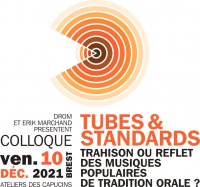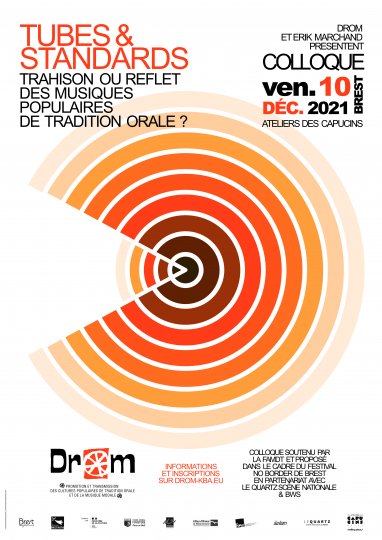Home > Modal music resource center > 6th SYMPOSIUM OF THE MODALITY CENTER: (...)
2021 - DECEMBER 10th IN BREST, CAPUCINS

A proposal by Drom and the FAMDT as part of the NoBorder festival in partnership with Le Quartz, Scène international and Bretagne (s) World Sounds.
FREE ENTRY
ON REQUIRED REGISTRATION
Whenever we aim at introducing musics from a certain cultural area, we rely almost spontaneously on tunes we believe to be the most well-known, these « hits and classics » shared by a whole community. It is precisely this link that the symposium « Hits and classics, betrayal or reflection of popular musics of oral tradition » initiated by Drom, within the framework of the No Border festival, is willing to question. What are the issues bound to the constitution and the growing interest of this type of repertory, that we might qualify as “emblematic”, to artistic and/or educational ends?
10:10am. GENERAL INTRODUCTION
Emmanuel Parent, maître de conférences à l’université de Rennes 2
A global introduction to these questions – nature of the “hit”, connection to the “traditional” musics – will be held by Emmanuel Parent from examples derived from his own practice as a researcher about black american musics.
10:30am. - 11:45am. PART I: Should we be off with those hits?
Moderator: Françoise Dastrevigne, chargée de mission au sein de la Délégation à la Musique du ministère de la Culture.
The hit borrows to the most trendy musical conventions in order to go beyond the aesthetic and “communitarian” frontiers of it’s usual listening area.
Therefore, the hit allows for a culture with specific musical characteristics to be more accessible to a non-specialist public. Its structure inherently leads it to a variable distance from the culture it came from: the hit can offer a genuine caricature as much as he can offer a proper reflection of its original specificities.
Attendees:
Robert Le Gall : Musician and arranger.
Marie Sauvet Malicorne : Singer, and musician.
Philippe Krumm : Journalist.
Evelyne Girardon : Singer, musician and comedian.
Sylvain Girault : An artist’s testimony programmed at the NoBorder festival.
11:50am. - 1:00pm. PROJECTION : Whose is this Song ?
Documentary film by Adela Peeva (Bulgaria), in original version with French subtitles (2003)
Adela Peeva sets out to meet the inhabitants of Serbia, Bosnia, North Macedonia, Turkey, as well as those of her own country Bulgaria, in order to find out where does this famous song with numerous names comes from : Usküdara, Katibim, Ruse kose curo imaš, Terk in America, Anadolka, Mu në bashtën tënde, Ya Banat Iskandaria… Almost everyone claims this song to be from the tradition of their country. The discussions are heated, and sometimes even take a political turn.
2:30pm. - 3:45pm. PART II: From hits to classics
Moderator : Erik Marchand, singer and transmitter.
This round table asks the question of a common, or even emblematic repertory, that would allow the learners and neophyte music lovers to touch upon the musical specificities of an aesthetic.
Subsequently, what do these emblematic pieces possess? Are they the same ones as those that the more or less advised public, within a community (from a nation to a micro-region), appreciate? Are these classics made of major pieces, the emblematic repertory that one or another educator has identified? Or are they an echo of the trendy tunes of a certain time, in a certain community?
Can the development of such a corpus let the artists share a common language (similar to jazz classics, wearing an improvisation and rhythmic style…), and ensure at the same time to diversify the examples in order to introduce to the learners the variety of expressions that characterise popular music.
How did teachers, educators and persons in charge of documentation centers engage with this issue?
Attendees:
Erik Marchand : Singer in Brittany.
Youenn Lange :Singer in Brittany.
Eric Desgrugillers : Multi-instrumentalist in Auvergne.
Denis Laborde : Ethnologist and research director.
4:00pm. - 5:30pm. PART III: When the instrument starts to sing
Moderator: Philippe Janvier, bell ringer and teacher in traditional music.
This round table will address the instrumental interpretation of sung sources (Tunes that are orally transmitted).
In Brittany, as well as numerous other regions of the world, the sources, the classics identified, are, mostly, sung sources. Musicians, shall they wish to respect the characteristics of these sources, are therefore facing the organological constraints of their own instruments, as well as their analysis, aware or not, about what they make with these sources.
How do the prosody, the modal scale, the variations in colour from verse to verse, all partake in the instrumental performance? Can we go up to the constitution of protocols guaranteeing this transmission which, in a way, provide the keys to listening?
Attendees:
Philippe Janvier : Bell ringer and teacher in Brittany
Marthe Vassallo : Singer in Brittany
Laurent Bigot : Bell ringer in Britanny
Romain Baudoin : Hurdy-gurdy player in Béarn
Henri Tournier : Flautist from India
Jean-Michel Veillon : Flautist in Britanny
Caroline Dufau : An artist’s testimony programmed at the NoBorder festival.
SUMMING UP AND CONCLUSION
By Emmanuel Parent and Erik Marchand.
CONTACT AND INFORMATION
research drom-kba.eu
09 65 16 71 21
